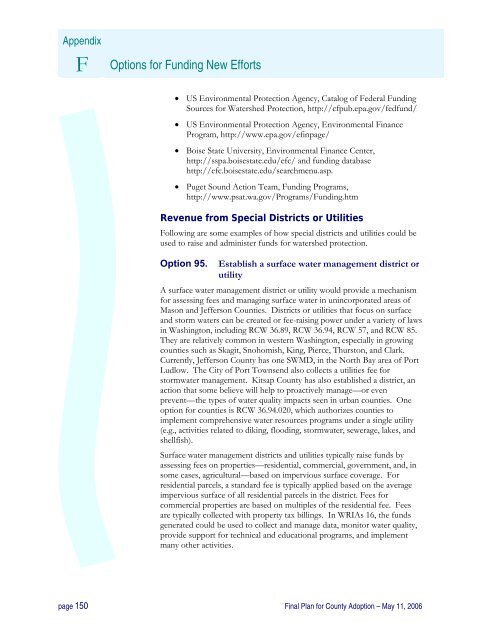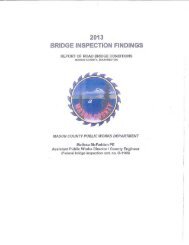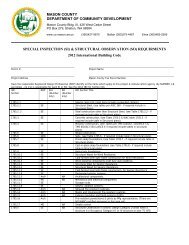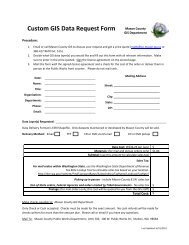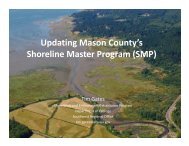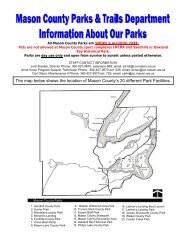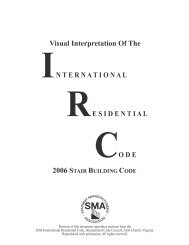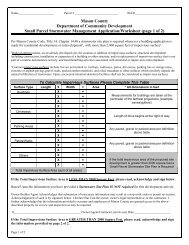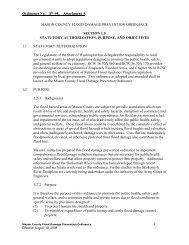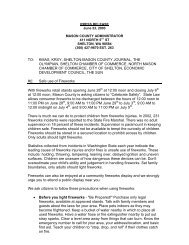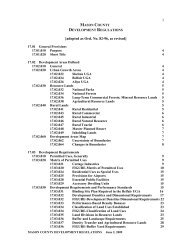Watershed Management Plan - Mason County
Watershed Management Plan - Mason County
Watershed Management Plan - Mason County
You also want an ePaper? Increase the reach of your titles
YUMPU automatically turns print PDFs into web optimized ePapers that Google loves.
Appendix<br />
F Options for Funding New Efforts<br />
• US Environmental Protection Agency, Catalog of Federal Funding<br />
Sources for <strong>Watershed</strong> Protection, http://cfpub.epa.gov/fedfund/<br />
• US Environmental Protection Agency, Environmental Finance<br />
Program, http://www.epa.gov/efinpage/<br />
• Boise State University, Environmental Finance Center,<br />
http://sspa.boisestate.edu/efc/ and funding database<br />
http://efc.boisestate.edu/searchmenu.asp.<br />
• Puget Sound Action Team, Funding Programs,<br />
http://www.psat.wa.gov/Programs/Funding.htm<br />
Revenue from Special Districts or Utilities<br />
Following are some examples of how special districts and utilities could be<br />
used to raise and administer funds for watershed protection.<br />
Option 95.<br />
Establish a surface water management district or<br />
utility<br />
A surface water management district or utility would provide a mechanism<br />
for assessing fees and managing surface water in unincorporated areas of<br />
<strong>Mason</strong> and Jefferson Counties. Districts or utilities that focus on surface<br />
and storm waters can be created or fee-raising power under a variety of laws<br />
in Washington, including RCW 36.89, RCW 36.94, RCW 57, and RCW 85.<br />
They are relatively common in western Washington, especially in growing<br />
counties such as Skagit, Snohomish, King, Pierce, Thurston, and Clark.<br />
Currently, Jefferson <strong>County</strong> has one SWMD, in the North Bay area of Port<br />
Ludlow. The City of Port Townsend also collects a utilities fee for<br />
stormwater management. Kitsap <strong>County</strong> has also established a district, an<br />
action that some believe will help to proactively manage—or even<br />
prevent—the types of water quality impacts seen in urban counties. One<br />
option for counties is RCW 36.94.020, which authorizes counties to<br />
implement comprehensive water resources programs under a single utility<br />
(e.g., activities related to diking, flooding, stormwater, sewerage, lakes, and<br />
shellfish).<br />
Surface water management districts and utilities typically raise funds by<br />
assessing fees on properties—residential, commercial, government, and, in<br />
some cases, agricultural—based on impervious surface coverage. For<br />
residential parcels, a standard fee is typically applied based on the average<br />
impervious surface of all residential parcels in the district. Fees for<br />
commercial properties are based on multiples of the residential fee. Fees<br />
are typically collected with property tax billings. In WRIAs 16, the funds<br />
generated could be used to collect and manage data, monitor water quality,<br />
provide support for technical and educational programs, and implement<br />
many other activities.<br />
page 150 Final <strong>Plan</strong> for <strong>County</strong> Adoption – May 11, 2006


